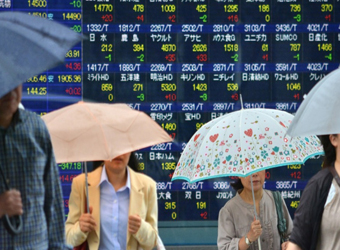Asia markets were mixed in morning trade on Thursday, after a lower finish in U.S. stocks following the release of the latest Federal Reserve minutes.
Australia’s ASX 200 opened higher but retraced gains to trade down 0.21 percent. The heavily weighted financial subindex traded down 0.16 percent, while the energy sector was down 1.19 percent and materials gained 0.21 percent.
Major banking stocks in the country were lower, with Commonwealth Bank shares down 0.24 percent, Westpac lower by 0.46 percent and the National Australia Bank losing 0.14 percent. ANZ shares were down 0.25 percent.
Japan’s Nikkei 225 was down 1.4 percent while the Topix index was lower by 1.18 percent. In South Korea, the Kospi slipped 0.56 percent.
Chinese mainland markets returned to trade after being shut for the Lunar New Year holidays. The Shanghai composite rose 1.31 percent in early trade while the Shenzhen composite added 0.84 percent.
Elsewhere, Hong Kong’s Hang Seng index was down 1.48 percent and Taiwan’s Taiex fell 0.82 percent.
Meanwhile, Dow Jones mini futures were down nearly 180 points, while Nasdaq and S&P 500 futures were off by 53.25 and 13.75 points, respectively.
In the Fed’s latest meeting minutes, officials saw increased economic growth and an uptick in inflation as justification to continue raising interest rates gradually.
Still, members of the Federal Open Market Committee did not raise rates at their January meeting.
The meeting was also the final one for Chair Janet Yellen, who led the Fed as it took the first steps to normalization following years of very low interest rates. She was succeeded by Jerome Powell, who is largely expected to continue Yellen’s strategy of gradual rate hikes.
“Our take is that the Minutes reflect events prior to the jump in hourly earnings seen in the January Jobs report and also prior to the extra spending bill passed by Congress early in February,” Rodrigo Catril, a senior currency strategist at the National Australia Bank, wrote in a morning note.
“This would suggest that there is a good chance that the current FOMC thinking has evolved towards a more hawkish tone since,” he added.
Meanwhile, U.S. Treasury yields whipsawed following the news. Yield on the 10-year note initially fell from session highs after the release, but recovered to reach a fresh four-year high.
In the currency market, the dollar index, which measures the greenback against a basket of currencies, traded at 90.058 at 9:51 a.m. HK/SIN, recovering from a previous low of 89.588.
Among other currency majors, the Japanese yen traded at 107.22 to the dollar. The Australian dollar traded at $0.7791 while the euro was at $1.2274.
Oil prices also fell Thursday morning during Asian hours. U.S. crude was down by 1.26 percent at $60.90 a barrel. Global benchmark Brent fell 0.98 percent to $64.78.
In company news, Qantas shares rose more than 9 percent in morning trade after the airline said it had its “highest-ever” first half underlying profit before tax for the six months ended Dec. 31, 2017. It rose 14.6 percent year on year to 976 million Australian dollars ($761.2 million), while statutory profit after tax increased nearly 18 percent to $607 million Australian dollars.
At 9:53 a.m. HK/SIN, Qantas shares traded higher at 7.12 percent.
Qantas CEO Alan Joyce told CNBC’s “Squawk Box” that the big earnings driver was the performance in the domestic market. He added that the company’s loyalty business was also growing well.
“Every part of the business pulled its weight,” Joyce said. He added that the international business was “slightly down, by around 6 percent, but we have huge changes coming into international next year, and we’re expecting a material improvement in its performance in financial year 2019.”
Some of those changes include the company’s efforts to re-balance its capacity away from the European market into Asia, and adding new routes from Melbourne and Brisbane to the United States.
Source: CNBC
